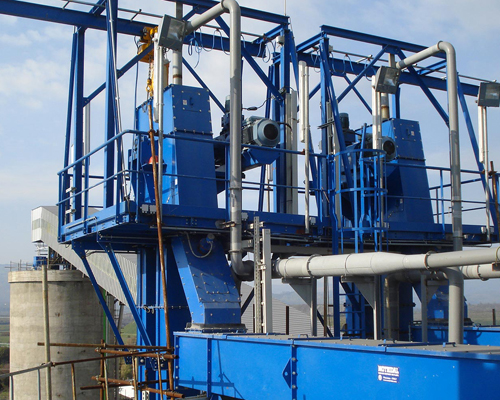The
belt bucket bucket is one of the most common conveyors. It is simple in structure and can carry bulk material vertically. In this paper, according to the characteristics of the bucket machine and the using environment, causes of the common faults of bucket machine were analyzed, and put forward the effective solution, for the bucket machine provides a theoretical basis for design and use.
1.The elevator fall out
The bucket is the carrying part of the
belt bucket elevator, which is more important. The bucket is an important part of the carrying part of the bucket elevator.The bucket and traction belt are connected by the bolts. Therefore, the bolt strength is not enough or the bolt is loose or the bolt and nut are not firmly welded that will caused the traction belt to fracture. At the same time, in the operation of the bucket there is a phenomenon of collision that will cause the bucket off. For this problem, we must first solve the problem of bucket connection bolts. Therefore, high-strength connection bolts should be used and we should check the device frequently to prevent loosening. It is important to secure the bolts after fastening to prevent them from loosening. This will reduce the bolt damage and thus reduce the probability of bucket shedding. At the same time, will often check bucket card touch phenomenon, found that bucket card touch timely solution.
2.The seriously wear of the bucket
In the operation of the bucket elevator, the bucket is used for picking up, conveying and unloading materials. Therefore, the anti-wear property of the bucket is very important for the service life of the
belt bucket elevator. Due to the close contact between the bucket and the material, it will cause rapid damage to the bucket; In particular, material size is too large, bucket in the material is more likely to cause wear. Lifting speed of the bucket is generally higher, so the bucket running speed is too large that will also cause material and bucket wear. Materials with high abrasion resistance should be used to make the bucket. At present, the nylon material bucket commonly used for the food industry, it can both improve the dustbin wear resistance and can reduce the dustbin weight. If the particle size of the material is larger, a bigger bucket elevator or a inclined belt conveyor should be chosen. At the same time, it is necessary to adjust the speed of the bucket elevator to ensure the smooth scooping and unloading of materials.
3.The seriously Material stock in the tail of bucket elevator
The material stock in the tail is one of the common faults of the
belt bucket elevator. Tail material stock of the main reason: (1) bucket lifting machine feeding uneven caused by the tail serious plugging material. (2) bucket elevator design of the conveyor can not meet the actual needs of too much material in the tail. (3) bucket elevator because of the speed or discharge point structure design is not reasonable. As a result, some materials could not be discharged smoothly and returned to the tail bin, resulting in material stock in the tail. The problem of material accumulation at the tail of the bucket elevator can be solved from the following aspects: strictly control the conveying capacity of the upstream conveying equipment of the bucket elevator, so that the material is supplied evenly, so as not to cause too much material input and block the material immediately; If the conveyor capacity of the bucket elevator can not meet the requirements of use, the bucket elevator with one or two big levels should be replaced to meet the needs; According to the characteristics of the conveying materials, the operation speed of the bucket elevator is designed scientifically and reasonably. Meanwhile, the position and shape of the unloading port are designed reasonably to ensure that the materials can be discharged completely and will not be returned to the tail of the machine. In this way, the failure of the accumulator at the tail of the machine can be effectively controlled.





